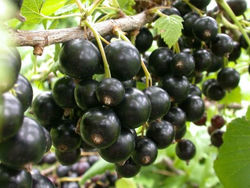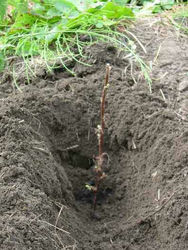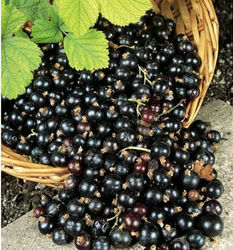 Indoors as Out: The Getty Villa in Malibu, California.
Indoors as Out: The Getty Villa in Malibu, California.To my mind, one of the most remarkable landscapes in the United States, perhaps the most remarkable, surrounds the Getty Villa in Malibu. For those of you unfamiliar with the place, the Villa, constructed by oil magnate J. Paul Getty in the 70s, is an exact replica of the Villa of the Papyri in Herculaneum, which was buried by the eruption of Mt. Vesuvius in AD 79. (The original villa, which still remains largely entombed in hardened volcanic rock, was excavated and mapped by tunneling during the 19th and 20th centuries.) The Getty structure, which steps down its sloping seaside site, is probably humanity’s best guess at what Roman gardens looked like. In neat, box-lined beds, ancient herbs and flower bloom, surrounding bronze sculptures and punctuated by flowing fountains. Along the colonnaded walls, frescos of country scenes and imaginary landscapes blur the distinction between architecture, garden, and the hilltops beyond. While the scale of the garden is immense and outside the range of anyone except multi-millionaires, the take-away lesson here is simple and applicable to almost any garden: link indoors and out. What strikes the visitor immediately is how gracefully the Getty gardens flow in, out, and around the structure, and how the house returns the gesture, embracing the gardens within its walls. Now granted, not all of us are blessed with a Mediterranean climate like that found in Malibu, but many are, and even in these places, modern construction is rarely successful in uniting house and garden the way the Getty Villa does. Each time I visit the Getty, I return to my own New England garden, and work on ways to improve how I see the garden from within, and how the garden sees the house from without. (The Getty is now split into two separate sites. The old villa in Malibu, which houses its extensive classical collections, and the new museum, strikingly situated on a hill overlooking all of LA and surrounded by modern gardens of great beauty. Both are well worth the trip. More information on visiting the at http://www.getty.edu/visit)
 Order and Unity: The Gardens of Colonial Williamsburg, Virginia
Order and Unity: The Gardens of Colonial Williamsburg, VirginiaThe product of another oil magnate, this time John D. Rockefeller Jr., the gardens that surround the restored homes and shops of Colonial Williamsburg provide an entirely different type of lesson for the garden traveler. In many ways, these small, enclosed gardens are far more accessible to modern visitor than the grand scale of the Getty. In fact, they aren’t too terribly dissimilar from the ¼ acre lots that surround homes all over the nation. What sets them apart from their modern brethren, however, is their sense of order and unity. Tour the various gardens of Williamsburg (and there are dozens) and in each you’ll be struck by how harmonious the relationship is between the various architectural features, the plantings, and the homes themselves. Fences, whose design derives from some element of the house architecture, move out in orderly lines from the house, and then conclude in logical ending points, so unlike many of today’s ill-conceived fence lines. Hardscape elements – walkways, arbors, trellis – share common materials and colors. And the plantings, so different from the messy masses that surround today’s homes, are in scale with the structures, and related to them by axial lines. In short, these gardens are comfortable – not to mention comforting – to spend time in, and my visits to Williamsburg have taught me always to be aware that when laying out a garden, the house needs to be the starting point for any garden design. So many landscapes today are conceived as if the house didn’t really matter, when in fact, it’s the style of the house, the color of the house, the situation of the house, the access to the house that must dictate the elements of the design. Think about it: without a house, you’re landscaping a field. It’s the house that drives the garden, not vice-versa, and that’s a lesson easily appreciated in Colonial Williamsburg. (More information at http://www.history.org)
 Working With Nature: Dumbarton Oaks in Washington DC
Working With Nature: Dumbarton Oaks in Washington DCJust a few hours away from Williamsburg, and a just a few miles from the Capital, sits one of the most magnificent gardens on the eastern seaboard: Dumbarton Oaks. Designed by the renowned landscape architect Beatrix Farrand for owners Mildred and Robert Woods Bliss in the 20s as their country home, the property now belongs to Harvard University and the Federal Government, who work jointly to preserve the 20 odd acres of gardens. Of course, when visiting a garden created by a true genius like Farrand, it would be easy to take away any number of well-taught lessons, and Dumbarton Oaks doesn’t disappoint. Clever aerial hedges surround grassy walks, custom designed furniture nestles among native plantings, terraced gardens lead down from the lovely Georgian home. But what strikes me as a professional designer is not so much what was accomplished – the Blisses after all were millionaires who could have instructed Farrand to create whatever style of garden they wished – but rather what wasn’t. The house is located on difficult, hilly terrain that borders Rock Creek (emphasis on rock), and instead of leveling vast stretches and clearing immense vistas to create a classical layout, Farrand worked within the constraints of nature, nestling garden rooms into the hillsides and connecting them with forested walks. That’s not to say the undertaking still wasn’t immense, but the garden plan works with nature in a way that few modern landscapes do. (One other success that immediately comes to mind is Frank Lloyd Wright’s Taliesin, in Spring Green, Wisconsin.) The take-away concept here is that whatever your site or climate, gardens succeed best when they co-exist with their surroundings, rather than attempting to dominate or control them. Dumbarton Oaks reminds us to embrace whatever conditions we’ve inherited – sun, shade, bog, desert – and make the most of them. (More information at http://www.doaks.org/gardens/virtual_tour)
So this summer, wherever your travels take you, do yourself a favor: bring along a camera, a small notebook, and spend some time visiting gardens. You, and your backyard, will be glad you did. http://michaelweishan.com/gardenblog/

 Заготавливать
черенки следует ранней весной, при набухании почек, но до появления
листьев, из однолетних побегов. Для черенкования годятся верхние части
растения, где имеются почки, но нет ветвей. Длина черенка может быть
различной, и сначала заготовку отрезают секатором или ножом с некоторым
запасом. При формировании черенка нужно учитывать, что его нижняя треть
будет закопана в землю при посадке, а на той части, которая останется
над землей, нужно оставить 3-4 почки. Из каждой такой почки потом
вырастет скелетная ветвь, а сам черенок превратится в стволик дерева.
Поэтому надо следить, чтобы оставляемые почки находились с разных сторон
черенка, чтобы в будущем скелетные ветви были расположены правильно, не
оказались все с одной стороны растения. Лишние, не нужные, почки
прищипываются или аккуратно срезаются. Вершинка черенка должна
непременно отсекаться.
Заготавливать
черенки следует ранней весной, при набухании почек, но до появления
листьев, из однолетних побегов. Для черенкования годятся верхние части
растения, где имеются почки, но нет ветвей. Длина черенка может быть
различной, и сначала заготовку отрезают секатором или ножом с некоторым
запасом. При формировании черенка нужно учитывать, что его нижняя треть
будет закопана в землю при посадке, а на той части, которая останется
над землей, нужно оставить 3-4 почки. Из каждой такой почки потом
вырастет скелетная ветвь, а сам черенок превратится в стволик дерева.
Поэтому надо следить, чтобы оставляемые почки находились с разных сторон
черенка, чтобы в будущем скелетные ветви были расположены правильно, не
оказались все с одной стороны растения. Лишние, не нужные, почки
прищипываются или аккуратно срезаются. Вершинка черенка должна
непременно отсекаться. Каждый
черенок заглубляется в землю комлевой частью, примерно на треть своей
длины. Земля вокруг посаженных черенков должна сразу же уплотняться и
хорошо проливаться водой. При этом исключается доступ воздуха к
подземной части растений и увеличивается процент приживаемости. Весьма
полезно накрывать череночники специальным нетканым материалом. Такой
материал хорошо пропускает внутрь солнечные лучи и дождевую воду, но
влагу и тепло отлично удерживает внизу, под собой. В таком случае
приживаемость черенков может достигать 100%. Когда на саженцах
появляются веточки из оставленных почек, а на них начинают расти листья,
что говорит о достаточном развитии корневой системы, надобность в
укрывном материале отпадает.
Каждый
черенок заглубляется в землю комлевой частью, примерно на треть своей
длины. Земля вокруг посаженных черенков должна сразу же уплотняться и
хорошо проливаться водой. При этом исключается доступ воздуха к
подземной части растений и увеличивается процент приживаемости. Весьма
полезно накрывать череночники специальным нетканым материалом. Такой
материал хорошо пропускает внутрь солнечные лучи и дождевую воду, но
влагу и тепло отлично удерживает внизу, под собой. В таком случае
приживаемость черенков может достигать 100%. Когда на саженцах
появляются веточки из оставленных почек, а на них начинают расти листья,
что говорит о достаточном развитии корневой системы, надобность в
укрывном материале отпадает. При
посадке саженцев на новое место нужно следить, чтобы основания
стволиков не оказались излишне заглублены ниже уровня почвы. Если это
произойдет, то замедлится развитие растений и снизится урожай. Поэтому
будет лучше допустить такое положение саженцев, когда после пересадки
они окажутся как бы на небольших бугорках. После посадки саженцев землю
вокруг них надо хорошо уплотнить и обильно пролить водой, чтобы мокрая
земля плотно облепила корни. Воздух, проникающий к корневой системе
весьма вреден, он сушит корни и может быть причиной замедления роста
растений.
При
посадке саженцев на новое место нужно следить, чтобы основания
стволиков не оказались излишне заглублены ниже уровня почвы. Если это
произойдет, то замедлится развитие растений и снизится урожай. Поэтому
будет лучше допустить такое положение саженцев, когда после пересадки
они окажутся как бы на небольших бугорках. После посадки саженцев землю
вокруг них надо хорошо уплотнить и обильно пролить водой, чтобы мокрая
земля плотно облепила корни. Воздух, проникающий к корневой системе
весьма вреден, он сушит корни и может быть причиной замедления роста
растений. На
третий год деревца дают первый урожай. Он еще не велик, составляет
всего от трех до пяти килограммов ягод. Но уже заметно, что сами ягоды
очень крупные, и по качеству превосходят те, что выросли на кустах, с
которых были взяты черенки. Это объясняется лучшими условиями развития,
которые были предоставлены саженцам деревцев в сравнении с условиями
произрастания стволиков в кустовом варианте. Могучая корневая система
деревцев способна в изобилии обеспечить ветви, листья и плоды
питательными веществами и влагой, поэтому количество и размер ягод на
плодовых ветвях очень и очень впечатляет. Многие ягоды кажутся поистине
гигантскими.
На
третий год деревца дают первый урожай. Он еще не велик, составляет
всего от трех до пяти килограммов ягод. Но уже заметно, что сами ягоды
очень крупные, и по качеству превосходят те, что выросли на кустах, с
которых были взяты черенки. Это объясняется лучшими условиями развития,
которые были предоставлены саженцам деревцев в сравнении с условиями
произрастания стволиков в кустовом варианте. Могучая корневая система
деревцев способна в изобилии обеспечить ветви, листья и плоды
питательными веществами и влагой, поэтому количество и размер ягод на
плодовых ветвях очень и очень впечатляет. Многие ягоды кажутся поистине
гигантскими.

 IGC offers turnkey greenhouse solutions with experience in the commercial and institutional greenhouse market since 1993. Over the years, we have provided unique controlled environments for a variety of challenging horticultural applications, both overseas and domestic. Because of this experience, our greenhouse experts
IGC offers turnkey greenhouse solutions with experience in the commercial and institutional greenhouse market since 1993. Over the years, we have provided unique controlled environments for a variety of challenging horticultural applications, both overseas and domestic. Because of this experience, our greenhouse experts  thoroughly understand all phases of project management; from design and permitting greenhouse structures, through installation and operation. Our team of greenhouse professionals can work directly with your architect, contractor or project manager to ensure the successful completion of your project.
thoroughly understand all phases of project management; from design and permitting greenhouse structures, through installation and operation. Our team of greenhouse professionals can work directly with your architect, contractor or project manager to ensure the successful completion of your project. 







 Sanctuary in your conservatory, benefits of a greenhouse
Sanctuary in your conservatory, benefits of a greenhouse There are lots of aspects to consider while building a greenhouse, but one of the most important of all is the design.
There are lots of aspects to consider while building a greenhouse, but one of the most important of all is the design. 









